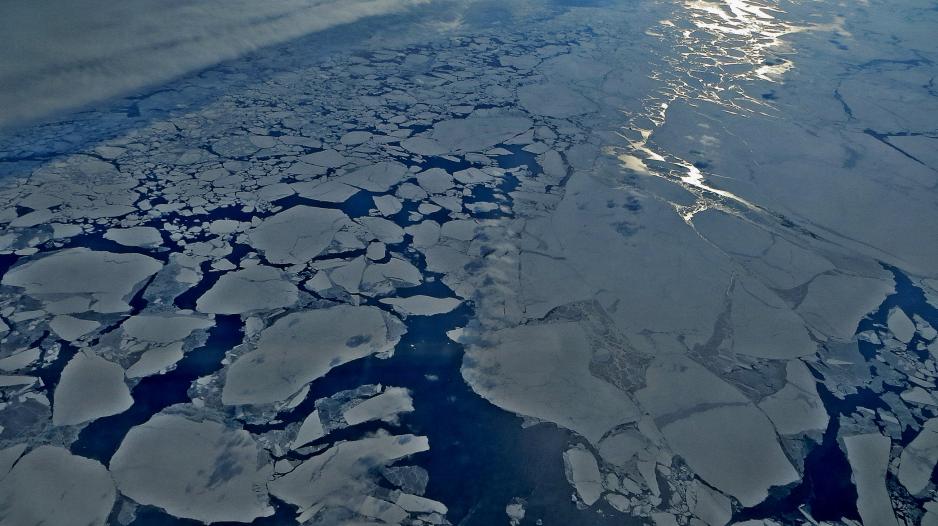Scientists Look to Pacific Ocean to Narrow Down Timeline of Ice-Free Arctic

Arctic sea ice northwest of Greenland. (Source: Malik on Flickr.com under CC BY 2.0)
Climate scientists say the Arctic Ocean will likely be ice-free in the coming decades. Now a new study aims to make a more accurate prediction about when this will occur.
Existing climate change studies are largely in agreement that Arctic sea ice will disappear almost completely during the summer by the middle of the 21st century. However, there remains significant uncertainty in the climate models about when the first ice-free Arctic September will occur, with most predictions ranging from 2030 until 2050. A new study published in Geophysical Research Letters looks to narrow down this uncertainty period by looking at temperature variations in the tropical Pacific and how these variations impact Arctic sea ice decline.
Climate scientists use a number of sophisticated computer models to make predictions about when the Arctic Ocean will see less than one million square kilometers of sea ice, defined as “ice free.” The long-term average of the 1980s-2000s saw about 7 million square kilometers of sea ice remain at the end of the summer in September. Over the past decade ice extent has decreased further and further and the current minimum was set in 2012 when ice extent stood at just 3.41 million square kilometers.
"The trajectory is towards becoming ice-free in the summer but there is uncertainty as to when that's going to occur," said James Screen, an associate professor in climate science at the University of Exeter in the U.K. and the lead author of the new study.
Looking at the Pacific to understand the Arctic
The new study, co-authored by James Screen and Clara Deser of the University of Boulder, looks at a natural variation of ocean temperatures in the Pacific to improve predictions about sea ice in the Arctic. The temperature variations are called Interdecadal Pacific Oscillation (IPO) and occur over a 15-30 year period. During the IPO the Pacific Ocean surface temperature varies by 0.5 degrees Celsius.
The Pacific Ocean entered a new warming phase about five years ago. The study takes into account the beginning of this warming trend in the Pacific in its calculations of when the Arctic will see its first ice-free summer. Variations in the IPO result in changes to the atmospheric wind patterns, which affect the amount of heat being transported to and from the Arctic.
The researchers conclude that the shift in the IPO from a colder to a warmer pattern results in an earlier ice-free Arctic by seven years on average, compared to climate model predictions that don’t take the IPO into account.
"The finding that we may be able to use the IPO phase to narrow the uncertainty range of over 20 years of when we may first see an ice-free Arctic Ocean in September is very promising," says Alexandra Jahn, an assistant professor in atmospheric and oceanic studies at the University of Colorado Boulder, who is not affiliated with the study.
A complex system
The new study also shows to a stronger degree the interconnectedness of the climate system, where changes outside of the Arctic can have lasting effects on the region and its climate. “The study is an important advance in our understanding of regional Arctic sea ice loss, the chaotic nature of ice loss, and the connections between Arctic sea ice loss and extrapolar regions,” confirms Jennifer Kay, assistant professor in environmental science, also of the University of Colorado Boulder.
Not only can climate patterns outside the polar regions affect climate change in the Arctic, but the Arctic can also affect long-term weather patterns in the mid-latitudes. Over the past decade a number of studies have shown that extremely cold winters in Europe may be the result of the reduction of Arctic sea ice. In a study published by Nature last year, scientists found a 15 percent slowdown of the Gulf Stream since the mid-20th century as a result of sea ice decline. Changes in Atlantic Ocean circulation may have an impact on weather patterns and extreme weather across Europe and North America.
Predictions vs. Reality
As the effects of climate change are becoming more noticeable scientists face a dilemma of accurately understanding a complex climate system that is undergoing rapid changes and at the same time making accurate predictions about what to expect decades from now. This is especially true in the Arctic where melting sea ice and opening shipping lanes are a very visual reminder of the dramatic and unprecedented changes.
On the one hand scientists must communicate the urgency of the issue to the public, but on the other hand they must be careful not to exaggerate or make incorrect predictions, which will then run up against reality a few years later and offer food for climate change skeptics to call into question the entire scientific community. Over the past decade some studies and scientists allowed for sensationalistic headlines by making very specific, and ultimately false, predictions about an ice-free Arctic Ocean as early as 2016.
As such, this new study will offer valuable insights and presents a new starting point for scientists to arrive at more accurate predictions of the impact of climate change on Arctic sea ice.

